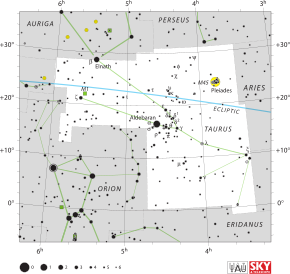Taurus (constellation)
| Constellation | |
 | |
| Abbreviation | Tau |
|---|---|
| Genitive | Tauri |
| Right ascension | 4 |
| Declination | +15 |
| Area | 797 sq. deg. (17th) |
| Main stars | 7 |
| Bayer/Flamsteed stars | 130 |
| Stars with planets | 3 |
| Stars brighter than 3.00m | 4 |
| Stars within 10.00 pc (32.62 ly) | 2 |
| Brightest star | Aldebaran (α Tau) (0.9m) |
| Messier objects | 2 |
| Meteor showers | Taurids Beta Taurids |
| Bordering constellations | Auriga Perseus Aries Cetus Eridanus Orion Gemini |
| Visible at latitudes between +90° and −65°. Best visible at 21:00 (9 p.m.) during the month of January. | |
Taurus (IPA: /ˈtɔːrəs/, Template:Lang-la, symbol ![]() , Unicode ♉) is one of the constellations of the zodiac. It sits large and prominent in the winter sky, between Aries to the west and Gemini to the east; to the north lie Perseus and Auriga, to the southeast Orion, and to the southwest Eridanus and Cetus.
, Unicode ♉) is one of the constellations of the zodiac. It sits large and prominent in the winter sky, between Aries to the west and Gemini to the east; to the north lie Perseus and Auriga, to the southeast Orion, and to the southwest Eridanus and Cetus.
Etymology
Taurus, like the Greek form tauros derives from a common Indo-European root meaning bull, ox or bison, and is related to English steer. See: Indo-European s-mobile.
Notable features
One of the few first magnitude stars in the sky, the bright red Aldebaran, sits in the middle of this constellation. The horns of the bull stretch off to the east, marked by β Tauri, traditionally shared with Auriga, and ζ Tauri.
Notable deep sky objects
In the west of the constellation lies one of the best known open clusters, easily visible to the eye, the Pleiades.
Behind Aldebaran lie the Hyades, the nearest distinct open star cluster, that with it form a V in the sky marking the bull's head.
Another object, visible in a telescope, is the Crab Nebula (M1), a supernova remnant northwest of ζ Tauri. The explosion, seen on Earth on July 4, 1054, was bright enough to be seen by day. It is mentioned in Chinese history texts.
Mythology for the term taurus
The identification of the constellation of Taurus as a bull is very old. However, we should be cautious when trying to link prehistoric phenomena with the symbolism of a number of ancient, literate cultures whose interactions and appropriations can be evaluated through the examination of their own written accounts, images and artifacts. Because prehistoric people did not document their lives in texts, we can only try to gauge the significance of their images by analyzing them in the context of other artifacts and physical evidence that survive from their world. We do not have their own words or voices to interpret pictures or explain if they are supposed to represent anything other than what they appear to be: massive bulls, galloping horses, deer and so on.
Nonetheless, Michael Rappenglück of the University of Münich believes that Taurus is represented in the Hall of the Bulls in the caves at Lascaux.[1] The French paintings date to approximately 15,000-13,000 BCE, i.e., long before their creators' descendants developed a written language that presents clear signs of their culture. The theoretical connection made between a constellation and just one of many images of bulls in the caves at Lascaux should arouse skepticism. Amateurs should note that the association between constellations and Lascaux has not entered canonical scholarly literature, nor respected textbooks that are revised and updated frequently to accommodate new, scholarly discoveries.
For further information regarding Rappenglück's theory, cf. a recent report by the British Broadcasting Corporation[2]. It should also be noted that large prehistoric images of bulls are found throughout Southwest France and Spain, joining prehistoric European sculptures of bulls rendered in stone, clay and bone whose significance continues to fascinate and intrigue. No one has been able to "solve" the puzzle they present to us nor crack any code we may wish was there. None of the murals conforms to contemporary notions of a framed composition, so the idea that one out of many paintings of bulls charts the skies with discernable coordinates on a compass must also raise doubts.
Shũr was the name used in ancient Babylon for Taurus.[3]
In Greek mythology, Zeus assumes the form of a magnificent white bull to abduct Europa, a legendary Phoenician princess, and thus, fathers Minos. The tale informs the names of constellations since it is necessary to traverse the area of sky known as the Sea to reach it. When passing through the Zodiac, it forms the origin of the myth of the Cretan Bull, one of The Twelve Labors of Heracles.
Minos inspires the name given to the ancient Aegean civilization of Crete. Minoan culture predates the rise of ancient civilizations on the Greek mainland. We can trace the ubiquitous image of the bull in Minoan culture to the Ancient Near Eastern world whose courts, tombs and temples are filled with images that tie their power to that of the bull.
Astrology
In Western Astrology the sun is in the sign of Taurus from April 21 to May 20 in the tropical zodiac and May 14 to June 19 in the sidereal zodiac.
References
- ^ http://www.infis.org/
- ^ http://news.bbc.co.uk/2/hi/science/nature/871930.stm
- ^ Allen, Richard Hinckley, "STAR NAMES Their Lore and Meaning", pg 382, Dover Publications, 1899 (1963) ISBN 0-486-21079-0
- Ian Ridpath and Wil Tirion (2007). Collins Stars and Planets Guide, HarperCollins, London. ISBN 978-0007251209.
External links
- The Deep Photographic Guide to the Constellations: Taurus
- BBC article on the possibility of Taurus being represented in Lascaux
- Star Tales – Taurus
